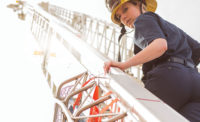In the 1970s, only 38 percent of women were in the workforce, according to the United States Department of Labor (DOL). Today, the DOL reports that 57 percent of women participate in the labor force — occupying a range of positions in an incredibly wide variety of industries.1 These industries include those historically dominated by men, such as firefighting, oil and gas, and utilities. While women still occupy a small percentage of the total workforce in these markets, efforts to encourage female participation are on the rise through industry-related associations, women’s groups and beyond.
Women in the fire service
This is especially true in firefighting — an industry that has seen a 73 percent increase in the number of female workers from 1983 to 2012, according to the National Fire Protection Association (NFPA).2 While women have been a part of the industry for centuries, it wasn’t until the 1970s that they were paid for their efforts. Firefighter’s ABC’s credits Judith Livers as the first documented paid female firefighter, with her hiring in 1974 by the Arlington County Fire Department.3
Now, women account for approximately 5.7 percent of the total employed in the occupation — and they are increasingly taking on higher positions, such as lieutenant, battalion chief, assistant chief and beyond. The International Association of Women in Fire and Emergency Services (iWomen) has aided in this growth since its founding in 1982. The iWomen association has provided resources, networking and communications for women in fire service; advocated for constructive changes within the industry; and developed policy guidelines for fire service — all in an effort to promote the participation of women in the fire service.4
Gaining ground
Beyond fire service, the oil and gas industry has also seen steady increases in female workers in recent years — with women now accounting for approximately 17 percent of total employment in the oil and natural gas and petrochemical industries, according to a study by the American Petroleum Institute (API). In the study, API also indicated that the aforementioned industries could fill 290,000 jobs with women through 2035. With this increase, the study contends that women would attain more high-level jobs in the industry, such as petroleum engineer, environmental scientist, accountant and technician.5
The utilities industry is also seeing gains in female workers, with 22.4 percent of the total number of employed persons being women. However, leadership roles in the power and utilities market are still dominated by men –– with women representing only five percent of board executive positions and 16 percent of board membership — according to Ernst & Young Global Limited’s (EY’s) annual Women in Power and Utilities (P&U) Index.6
PPE must be sized to fit
With the increase of women in the workforce comes an increased need for workwear engineered with women in mind. This is especially true for industries requiring PPE such as flame-resistant (FR) clothing, since the effectiveness of such products can depend on their fit. In fact, OSHA 1910.132, a safety standard outlining the general requirements for PPE, states that employers are to select PPE that properly fits each affected employee.7
Historically, FR clothing providers have focused their efforts on men’s clothing, forcing women to wear oversized, poor-fitting garments that aren’t conducive to the movement required in their jobs. This is of particular concern in industries requiring extensive physical labor. From rolling shirtsleeves and pant legs to leaving shirttails untucked, in the past, women have had to make their own modifications to their FR workwear — many of which compromise safety — in order for it to be comfortable enough to wear during an eight-hour workday. In a study conducted by Cornell University's Institute for Women and Work, researchers interviewed 175 female firefighters in depth and found that 80 percent said they were issued ill-fitting equipment — signaling the need for improved safety gear for female firefighters.8
New FR clothing
To better serve the needs of women in industries at risk for certain hazards — like arc flash, flash fire, molten-metal splatter and flammable chemicals — that necessitate the use of FR clothing, some FR clothing manufacturers have introduced styles engineered specifically for the female stature. These styles include features meant to provide a better fit for women — including shirts with vertical darts and contoured seams and pants with a lower rise and an improved fit through the waist, seat and thighs.
As women’s participation in the workforce continues to grow, the need for safe, comfortable and properly fitting FR garments will expand as well. More variety in FR women’s workwear will allow for increased wearer compliance and ensure that women have the highest level of protection on the job.
1 www.dol.gov/wb/stats/facts_over_time.htm
2 www.nfpa.org/research/reports-and-statistics/the-fire-service/administration/firefighting-occupations-by-women-and-race
3 www.firefightersabcs.com/files/Twelve_Amazing_Female_Firefighters.pdf
4 www.i-women.org/mission/
5 www.api.org/~/media/Files/Policy/Jobs/16-March-Women-Minorities-Jobs/Minority-and-Female-Employment-2015-2035.pdf
6 www.ey.com/GL/en/Industries/Power---Utilities/Women-power-and-utilities
7 www.osha.gov/pls/oshaweb/owadisp.show_document?p_table=STANDARDS&p_id=9777
8 www.upi.com/Health_News/2008/05/12/4-percent-of-US-firefighters-women/22871210625538/




